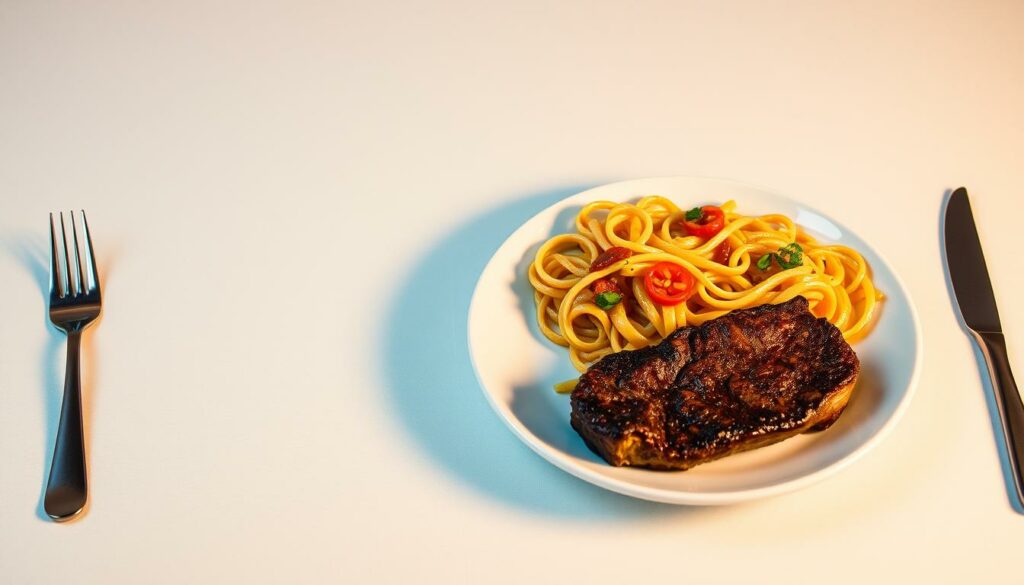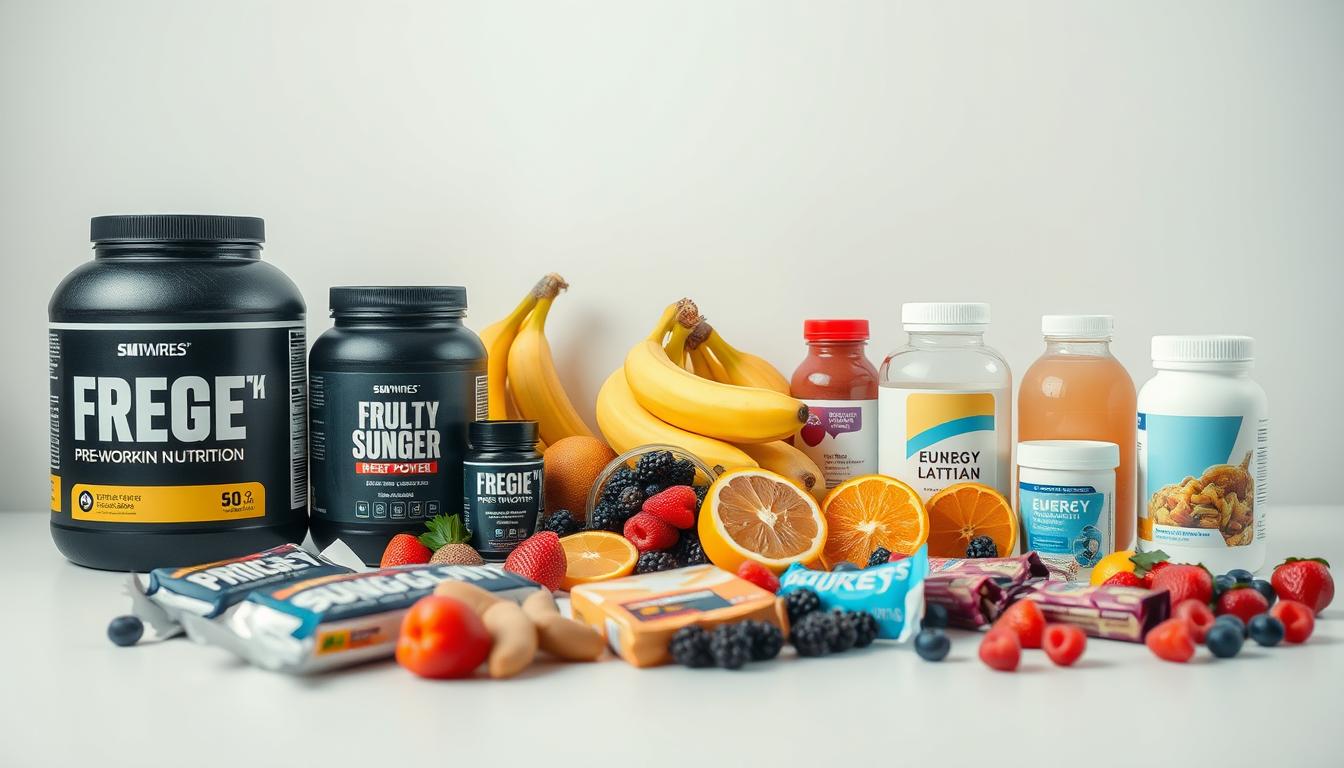Are you tired of restrictive dieting that makes you feel deprived? You’re not alone. Many people find it hard to give up their favorite foods to lose weight. But, sustainable weight loss isn’t about feeling deprived. It’s about making choices that you can keep up with for a long time.
The secret to losing weight is finding a balance that lasts. By choosing healthy eating habits and adding your favorite foods, you can reach your goals. You won’t feel like you’re missing out on your lifestyle.
Key Takeaways
- Focus on sustainable weight loss instead of quick fixes.
- Add your favorite foods to your diet for lasting success.
- Build healthy eating habits that you can stick to.
- Avoid restrictive dieting that makes you feel deprived.
- Find a balance that fits your lifestyle.
The Science Behind Fat Loss
Understanding fat loss is key for sustainable weight loss. It’s not just about cutting calories or following trends. It’s about knowing the basic principles of fat loss.
Understanding Caloric Deficit
A caloric deficit happens when you eat fewer calories than you burn. This leads to weight loss. You can achieve this by eating less and moving more.
How Many Calories You Actually Need
Your calorie needs depend on your age, sex, weight, height, and how active you are. For example, a sedentary woman might need 1,600 to 2,000 calories daily. An active man might need 2,400 to 3,000 calories.
| Activity Level | Calories Needed (Women) | Calories Needed (Men) |
|---|---|---|
| Sedentary | 1,600-2,000 | 2,000-2,400 |
| Moderately Active | 1,800-2,200 | 2,200-2,800 |
| Active | 2,000-2,400 | 2,400-3,000 |
The Role of Metabolism in Weight Loss
Your metabolism is key in fat loss. It shows how well your body burns calories. Your age, genetics, and muscle mass can affect your metabolic rate.

Why Restrictive Diets Often Fail Long-Term
Restrictive diets are hard to stick to long-term. They often lead to weight loss and gain. This is because these diets are too strict or cut out whole food groups.
Why You Don’t Need to Abandon Your Favorite Foods
Losing fat doesn’t mean you have to give up the foods you love. In fact, restrictive dieting can often have the opposite effect of what’s intended.
The Psychological Impact of Food Restriction
Restrictive eating can lead to feelings of deprivation, which can negatively impact your mental health. When you completely cut out your favorite foods, it can create an unhealthy relationship with food.
Deprivation can lead to obsession, making you feel like you’re missing out on the enjoyment of eating.
How Deprivation Leads to Binge Eating
When you restrict certain foods for too long, you might find yourself craving them more intensely. This can lead to binge eating episodes, which can be detrimental to your weight loss efforts and overall health.
Studies have shown that individuals who practice portion control and allow themselves the occasional treat tend to have more sustainable weight loss results.
The Importance of Sustainable Dietary Habits
Developing a balanced eating habit is key for long-term weight management. This involves incorporating a variety of nutrient-dense foods into your diet while also allowing for indulgences.
Building a Healthy Relationship with Food
To build a healthy relationship with food, focus on moderation instead of restriction. This means enjoying your favorite foods in controlled portions.
| Food Category | Nutrient Density | Portion Control Tips |
|---|---|---|
| Fruits and Vegetables | High | Fill half your plate with these |
| Lean Proteins | High | Use a palm-sized portion |
| Whole Grains | Medium to High | Choose whole grains over refined grains |
| Favorite Treats | Low to Medium | Enjoy in moderation, control portion sizes |

By focusing on sustainable dietary habits and practicing portion control, you can enjoy your favorite foods while working towards your weight loss goals.
How to Lose Fat Without Giving Up Your Favorite Foods
You don’t have to give up your favorite foods to get leaner. It’s about finding a balance. This balance lets you enjoy your favorite foods while working towards your fat loss goals. It’s all about flexible dieting and mindful eating.
The 80/20 Principle of Balanced Eating
The 80/20 principle is simple. It says 80% of your food should be healthy, whole foods. The other 20% can be your favorite treats. This way, you can enjoy your favorite foods while keeping your diet balanced.
Creating a Sustainable Caloric Deficit
To lose fat, you need to eat fewer calories than you burn. But, this deficit should be small and steady. Big cuts in calories are hard to keep up with and often don’t work.
Incorporating Treats Without Sabotaging Progress
You can add your favorite foods to your diet without losing your way. It’s all about planning and strategic timing.
Strategic Timing of Favorite Foods
Choose the right time to enjoy your favorite foods. Eating them after a workout or on active days can help. This way, you can enjoy your treats without ruining your progress.
By using these strategies, you can lose fat in a balanced and sustainable way. You don’t have to give up your favorite foods. This approach is good for your health and helps you have a better relationship with food.
Portion Control Strategies That Actually Work
Portion control isn’t about cutting out food. It’s about making smart choices that help you lose weight. By using a few simple tips, you can start eating healthier for good.
Using Smaller Plates and Containers
Using smaller plates and containers is a great way to control portions. It tricks your mind into eating less. Studies show we eat more with bigger portions. So, using smaller dishes can help you eat fewer calories.
Measuring Portions Without Obsessing
Measuring your food can help you understand healthy sizes. You don’t need to measure every meal. But checking your portions now and then can keep you on the right path.
Mindful Eating Techniques
Mindful eating means focusing on your food. It’s about enjoying each bite and listening to your body. Pay attention to the flavors and textures, and stop when you’re satisfied.
Hunger and Fullness Cues
It’s important to know when you’re hungry or full. Eat slowly and check in with your body. Stop when you’re satisfied, not stuffed.
By adding these strategies to your daily life, you can enjoy your favorite foods while losing weight.
Nutrient Density vs. Calorie Density
It’s important to know the difference between nutrient density and calorie density. Nutrient density is about how many good nutrients a food has compared to its calories. Calorie density is how many calories a food has per unit of weight or volume.
Understanding Food Quality
Foods can be sorted by their nutrient and calorie content. Nutrient-dense foods like leafy greens, lean proteins, and whole grains have lots of nutrients but not many calories. Calorie-dense foods, which are often high in fats and sugars, have a lot of calories but not many nutrients.
Balancing Nutrient-Dense Foods with Treats
A good diet has both nutrient-dense foods and treats. You can have your favorite foods sometimes while eating more nutrient-dense foods. Here are some tips:
- Eat whole, unprocessed foods as much as you can.
- It’s okay to enjoy treats without feeling bad.
- Make nutrient-dense foods the main part of your meals, saving treats for special times or as rare treats.
Creating Satisfying Meals That Support Fat Loss
To make meals that are both filling and healthy, mix protein, healthy fats, and complex carbs. This helps you stay full and meet your nutritional needs. Here are some examples:
- Grilled chicken with quinoa and steamed veggies.
- Salads with lean protein, nuts, and colorful veggies.
- Whole grain toast with avocado and eggs.
By understanding nutrient density and calorie density, you can make better choices. These choices help you lose fat without feeling like you’re missing out.
Smart Food Swaps That Don’t Feel Like Sacrifice
Changing your diet doesn’t mean giving up on foods you love. Smart swaps can balance things out. A few tweaks to your eating habits can let you enjoy favorites while reaching weight loss goals.
Healthier Versions of Common Comfort Foods
Many comfort foods can be made healthier without losing their charm. For instance, healthier mac and cheese uses whole wheat pasta, less cheese, and steamed veggies.
- Swap traditional pasta for whole grain or zucchini noodles to reduce calories and increase nutrient density.
- Choose baked or grilled options instead of fried for comfort foods like chicken tenders or fries.
Ingredient Substitutions That Cut Calories
Simple swaps can lower calories in your favorite dishes. Greek yogurt instead of sour cream or mayonnaise cuts calories and boosts protein.
- Replace high-calorie ingredients with lower-calorie alternatives, such as using avocado oil instead of butter for baking.
- Opt for lean proteins like chicken, fish, or tofu to reduce fat intake.
Flavor Enhancers That Reduce Need for Fat and Sugar
Adding flavor without extra fat or sugar is easier than you think. Spices and herbs can make a big difference.
Spices and Herbs That Boost Satisfaction
Certain spices and herbs add flavor and satisfaction. For example, cinnamon enhances oatmeal or yogurt, while turmeric adds warmth to soups and curries.
- Garlic and ginger add depth without calories.
- Chili peppers boost metabolism and add spice.
By adding these smart swaps to your diet, you can enjoy your favorite foods while working towards weight loss. It’s about making lasting, lifestyle-friendly changes.
Meal Planning for Weight Loss Success
Meal planning helps you create a balanced diet for weight loss. It’s more than picking what to eat. It’s about planning your nutrition to meet your weight loss goals.
Weekly Preparation Strategies
Start with preparation for effective meal planning. Spend time each week planning your meals. This can greatly help your weight loss journey. Here are some strategies to consider:
- Create a weekly meal calendar
- Make a grocery list based on your meal plan
- Prep ingredients in advance to save time during the week
Scheduling Indulgences
Allowing yourself to enjoy favorite foods is key. Scheduling treats helps you satisfy cravings without losing focus.
Tips for scheduling indulgences:
- Plan your treats in advance to avoid impulsive decisions
- Choose smaller portions to keep calorie intake in check
- Balance your indulgences with healthier meals throughout the day
Balancing Macronutrients for Optimal Results
A balanced diet with the right macronutrients is essential for weight loss. The right mix of proteins, carbohydrates, and fats supports health and weight loss goals.
Consider the following macronutrient balance tips:
- Protein: Essential for muscle repair and maintenance
- Carbohydrates: Provide energy for daily activities
- Fats: Important for hormone regulation and overall health
Sample Meal Plans That Include Favorite Foods
Here’s an example of how to include favorite foods in a weight loss meal plan:
| Day | Breakfast | Lunch | Dinner |
|---|---|---|---|
| Monday | Oatmeal with fruit | Grilled chicken salad | Baked salmon with quinoa |
| Tuesday | Scrambled eggs with spinach | Turkey wrap with avocado | Grilled chicken with roasted vegetables |
Exercise Strategies to Support Your Nutrition Plan
To reach your fat loss goals, mix a balanced diet with good exercise plans. Exercise not only burns calories but also builds muscle. This boosts your metabolism.
Strength Training for Metabolic Health
Strength training is key for keeping your metabolism healthy while losing fat. It builds muscle, which raises your resting metabolic rate (RMR). This means your body burns more calories even when you’re not moving.
Do 2-3 strength training sessions a week. Focus on big exercises like squats, deadlifts, and bench presses.
Use progressive overload to keep challenging your muscles. This means slowly increasing the weight or resistance. It helps you keep losing fat.
Cardio Considerations for Fat Loss
Cardio is also vital for losing fat. Running, cycling, or swimming burns calories and boosts heart health. For the best results, try high-intensity interval training (HIIT).
How to Structure Workouts Around Your Eating Habits
Plan your workouts around your meals for better performance and recovery. Eat a balanced meal with protein and carbs 1-2 hours before working out. After, eat something with protein and carbs within 30-60 minutes to help your body recover.
| Workout Timing | Nutrition Recommendation | Benefits |
|---|---|---|
| Pre-Workout | Balanced meal with protein and carbs 1-2 hours before | Optimal energy for workout |
| Post-Workout | Protein and carbs within 30-60 minutes | Enhanced recovery and muscle growth |
Managing Social Situations and Dining Out
You don’t have to give up socializing or your favorite foods to lose fat. Social eating and dining out can be tough, but you can handle them with the right tips.
Restaurant Strategies That Don’t Ruin Your Progress
Choose restaurants with healthy options when you eat out. Look for grilled, baked, or steamed dishes and avoid fried ones. You can also ask for special requests, like dressing on the side or no extra salt.
Handling Food-Centered Social Events
At social events, aim for healthy choices but don’t skip treats entirely. Follow the 80/20 rule: eat healthy 80% of the time and indulge 20% of the time. This balance lets you enjoy social events while staying on track.
Alcohol Considerations During Fat Loss
Alcohol can add a lot of empty calories. Choose drinks like wine or spirits with low-calorie mixers. Remember to watch your calorie intake and limit alcohol to special times.
By being careful with your choices and using these tips, you can enjoy eating out and socializing while losing fat.
Common Pitfalls and How to Overcome Them
Knowing the common obstacles in weight loss can help you get ready and beat them. As you try to lose fat without giving up your favorite foods, it’s key to know what challenges might come your way.
Weekend Overeating
Weekends often mean social events and relaxed schedules, which can lead to eating too much. To fight this, plan your weekend meals ahead and set limits on how much you eat. Portion control and mindful eating can also help you enjoy your favorite foods without eating too much.
All-or-Nothing Thinking
Thinking your diet is either perfect or a total failure can be frustrating. Instead, try a flexible dieting approach that lets you have treats sometimes. This way, you can stay on track while also enjoying your favorite foods.
Emotional Eating Triggers
Emotional eating can ruin your weight loss plans. The first step to beating it is to know what triggers it in you.
Building Healthier Coping Mechanisms
Swap emotional eating for healthier ways to cope, like exercise, meditation, or journaling. This way, you’ll be ready to handle your emotions without turning to food.
By knowing these common pitfalls and how to overcome them, you can reach your weight loss goals more easily.
Conclusion: Sustainable Fat Loss for Life
Losing fat without giving up your favorite foods is possible. A balanced and flexible dieting approach makes it achievable. By understanding fat loss science and using strategies like portion control, you can create a lasting weight loss plan.
Flexible dieting lets you enjoy your favorite treats in moderation. This reduces feelings of deprivation and boosts long-term success chances. It helps you develop a healthier food relationship and keeps your weight loss steady.
To keep losing weight, focus on progress, not perfection. Stay committed to your goals and don’t be too hard on yourself when you hit a bump. With a flexible and balanced diet, you can reach your weight loss goals and live a healthy life.


